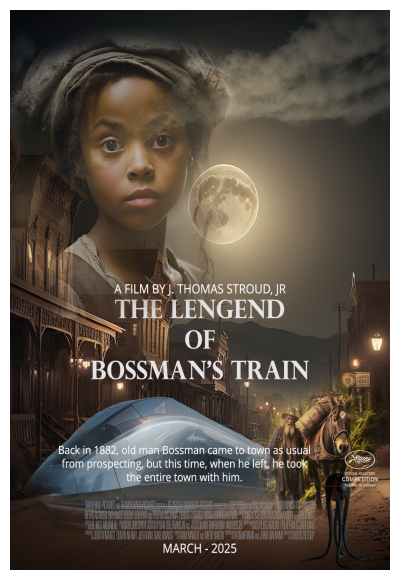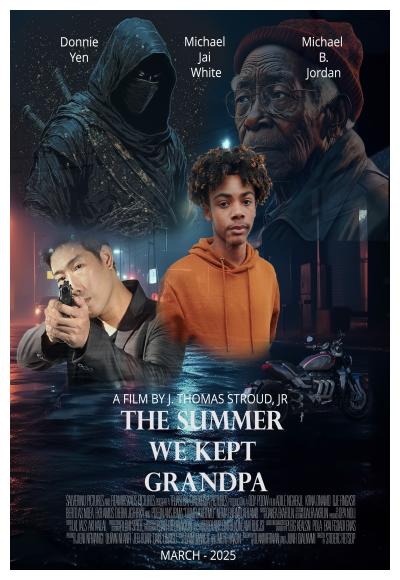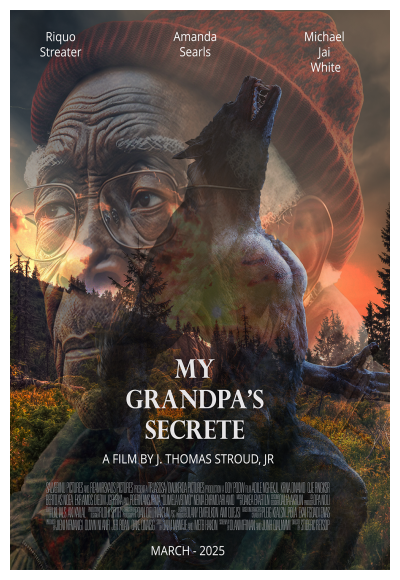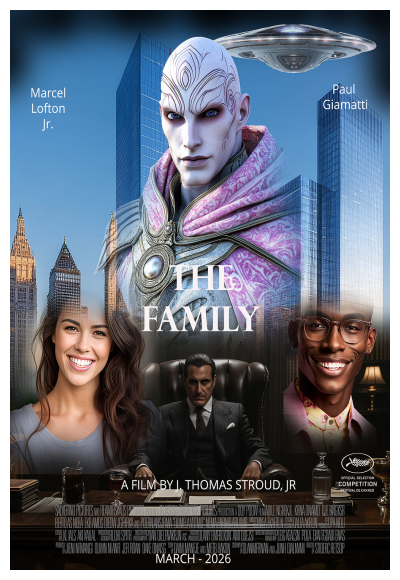
Synopsis/Details
All Accolades & Coverage
Coverage Report by Nolan Filmmaker's Studio
LOGLINE:
A mysterious being known as Hakim, who possesses supernatural powers, must protect the peaceful Syrian village of Tel Shegheb from the impending attack of two rival warlords. As he navigates his hidden identity and newfound love with Nasya, the stakes rise when the village's survival and his family's safety hang in the balance, forcing him to confront his past and unleash his true power to save them all.
OVERALL IMPRESSION:
"Heaven's Knight" presents an intriguing blend of historical fiction and fantasy, set against the backdrop of 1930s
Syria. The script opens with a compelling visual and emotional hook: a village under the threat of military invasion and
a mystical guardian in the form of a dog that transforms into a massive beast. This aligns well with Robert McKee's
principle of inciting incidents that propel the narrative forward. However, the script could benefit from a clearer
adherence to Blake Snyder's "Save the Cat" beat sheet, particularly in establishing the protagonist's transformation
and stakes.
Character development is a mixed bag; while Nasya and Hakim’s relationship is tenderly portrayed, offering
emotional engagement, Hakim’s backstory and mystical abilities lack depth and clarity. More focus on his internal
conflict and past could enhance audience connection. The pacing, while initially gripping, tends to meander with
prolonged scenes that could be tightened to maintain tension and momentum, crucial elements in both Snyder's and
Truby's storytelling frameworks.
The script's appeal lies in its unique setting and the fusion of myth with historical elements, which could captivate
audiences seeking a richly textured narrative. However, the dialogue occasionally leans towards exposition rather
than character-driven interaction, which may hinder the viewer's emotional investment. Overall, refining the script's
structure and character arcs could elevate its potential, making it a more cohesive and engaging story experience.
SYNOPSIS:
**Synopsis of "Heaven’s Knight"**
Set against the backdrop of the Syrian Desert in 1932, "Heaven’s Knight" opens with a dramatic and mystical
encounter in the village of Tel Shegheb. A mongrel dog named Fez transforms into a monstrous guardian to fend
off an attack by Mullah Sashi's soldiers. This supernatural event sets the stage for a story that intertwines myth,
love, and conflict.
Two years earlier, we meet Nasya Fuwan, a young shepherdess who encounters Hakim, a mysterious stranger living
in the ruins of Serjilla. Hakim, who claims to be an orphan, becomes entwined with Nasya and her family, bringing
prosperity and protection to their village. As their relationship blossoms into love, Hakim's enigmatic nature and his
connection to the desert's mystical forces become more apparent.
The village of Tel Shegheb finds itself caught in the crossfire between two warring factions led by Mullah Sashi and
Chief Ferrani. The village council, including Nasya's father, Kasib, is forced to make a strategic alliance to ensure their
survival. Kasib and Hakim embark on a perilous journey to seek aid from Chief Ferrani, only to discover treachery
and imminent danger to their village.
As the narrative unfolds, it is revealed that Hakim is not merely a man but a powerful desert spirit named Amadi,
who has taken human form. His love for Nasya and their child binds him to the human world, but the looming threat
to Tel Shegheb forces him to unleash his true powers.
In a climactic confrontation, Amadi's supernatural abilities are unleashed to protect the village from annihilation.
Despite his efforts, tragedy strikes, and Nasya is mortally wounded. With her dying breath, she implores Hakim to
remain connected to humanity through their son, Abraxxas.
The story concludes in a poignant and mystical transition, as Hakim ensures the safety of his son and entrusts him to
Saleemah, Nasya's friend. As the narrative jumps to the present day, the legacy of Hakim and Nasya's love continues,
with their lineage holding the key to a mystical power that transcends time.
"Heaven’s Knight" weaves a tale of love, sacrifice, and the enduring battle between human frailty and supernatural
strength, set against the timeless and mystical backdrop of the desert.
COMMENTS:
**Script Review: "Heaven’s Knight"**
**Overall Story Structure:**
"Heaven's Knight" unfolds a mystical and action-packed narrative, blending historical elements with supernatural
themes. The script attempts to weave a complex tapestry of past and present, myth and reality, through the journey
of Hakim, a seemingly ordinary man with extraordinary powers. The story is framed within a classic three-act
structure, although its chronological jumps and the introduction of numerous characters may disrupt the flow for
some readers.
Act One introduces us to the world of 1932 Syrian desert and the village of Tel Shegheb. It sets up the core conflict
with the arrival of military forces and the mysterious transformation of the dog, Fez. The inciting incident effectively
piques curiosity, although the stakes could be more clearly defined early on.
Act Two explores the relationships and the village dynamics, especially with the introduction of Hakim and his
interactions with Nasya and her family. This act is pivotal as it develops the central love story and the supernatural
elements. However, the narrative could benefit from a stronger midpoint to heighten tension and provide a clearer
direction for the protagonist's journey.
Act Three escalates the conflict with the impending attack on the village, culminating in the climactic reveal of
Hakim's true nature. The resolution ties back to the thematic elements of protection and sacrifice, although the
conclusion's jump to 2019 and the Vatican subplot feels abrupt and disconnected from the core narrative.
**Character Development:**
Hakim, the protagonist, is an enigmatic figure whose backstory and motivations are gradually revealed. His
character arc, from a mysterious desert dweller to a supernatural protector, is intriguing but lacks emotional depth
due to sparse internal conflict. Drawing on John Truby's "The Anatomy of Story," Hakim would benefit from a clearer
moral and psychological need to propel his transformation.
Nasya serves as the emotional anchor, her relationship with Hakim providing a heartfelt subplot. However, her
character could be more proactive, with her own desires and arcs beyond her connection to Hakim. Other characters,
like Kasib and Raheemah, function well within the family dynamic but remain largely static.
Antagonists such as Mullah Sashi and Tengi are presented as two-dimensional foes. Their motivations and backstories
are underexplored, reducing their impact as credible threats. Developing these antagonists with richer
backgrounds and clearer stakes would enhance the story's tension.
**Dialogue Quality:**
The dialogue in "Heaven’s Knight" often serves to advance the plot and provide exposition. However, it sometimes
falls into the trap of being too on-the-nose or laden with clichés, lacking the subtlety recommended by Robert McKee
in "Story." Characters frequently state their feelings and intentions rather than showing them through actions and
subtext.
Improving dialogue authenticity and distinctiveness could help differentiate characters and make their interactions
more engaging. Additionally, reducing the use of exposition-heavy conversations would allow the narrative to unfold
more organically.
**Pacing:**
The script's pacing fluctuates, with moments of tension interspersed with slower, more dialogue-driven scenes. The
pacing is strongest in the action sequences and Hakim's transformative moments, which are vivid and dynamic.
However, the narrative occasionally stalls during exposition-heavy sections, particularly when introducing the
numerous characters and their backstories.
Implementing Blake Snyder's "Save the Cat" principles, such as creating more distinct set pieces and ensuring each
scene serves a clear purpose, could streamline the narrative and maintain reader engagement.
**Emotional Impact:**
"Heaven’s Knight" strives for an emotional resonance, particularly through the love story between Hakim and Nasya
and the themes of sacrifice and protection. While these elements are present, the emotional impact is somewhat
diluted by the script's structural and pacing issues. Strengthening the protagonist's internal conflict and providing
more nuanced character interactions could deepen the emotional core.
**Engagement with Intended Audience:**
The script appears aimed at audiences who appreciate supernatural thrillers with historical and cultural elements.
However, the blending of genres and the script's sprawling narrative may challenge its accessibility. Clarifying the
target audience and aligning the script's tone and style accordingly could enhance its appeal.
**Adherence to Storytelling Techniques:**
"Heaven’s Knight" attempts to adhere to established storytelling techniques but would benefit from a more focused
approach. Clarifying the protagonist's goals, refining character arcs, and ensuring each scene advances the plot or
deepens character development are crucial steps in enhancing the script's overall impact.
**Conclusion:**
"Heaven’s Knight" presents a fascinating premise with potential for a rich, engaging story. Its blend of mythology,
history, and supernatural elements is intriguing but requires careful refinement to achieve narrative cohesion and
emotional depth. By addressing pacing issues, enhancing character development, and tightening dialogue, the script
could fulfill its promise and deliver a compelling cinematic experience.




















